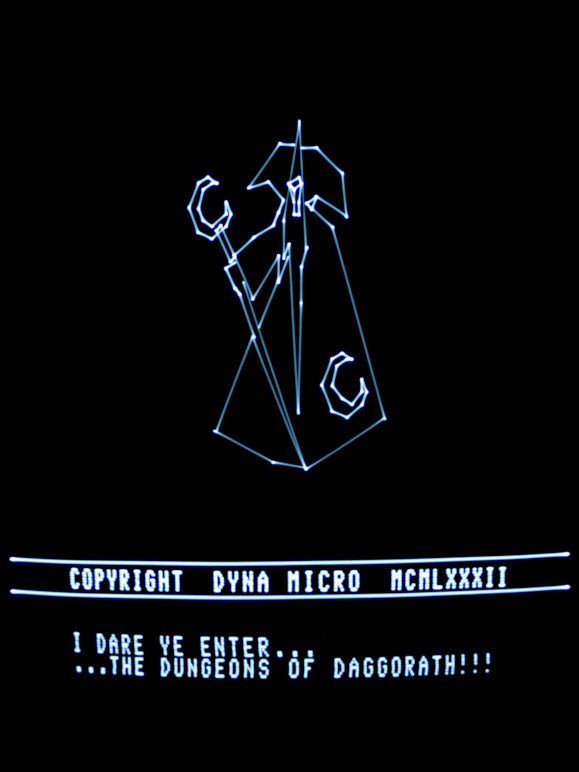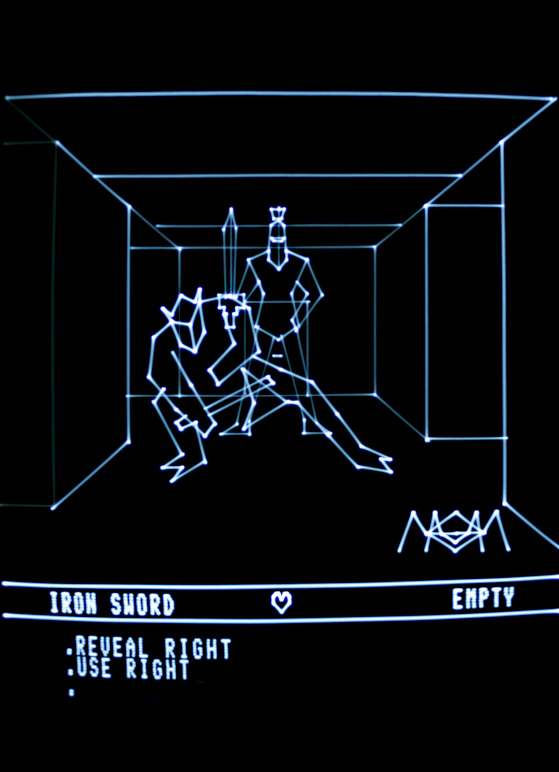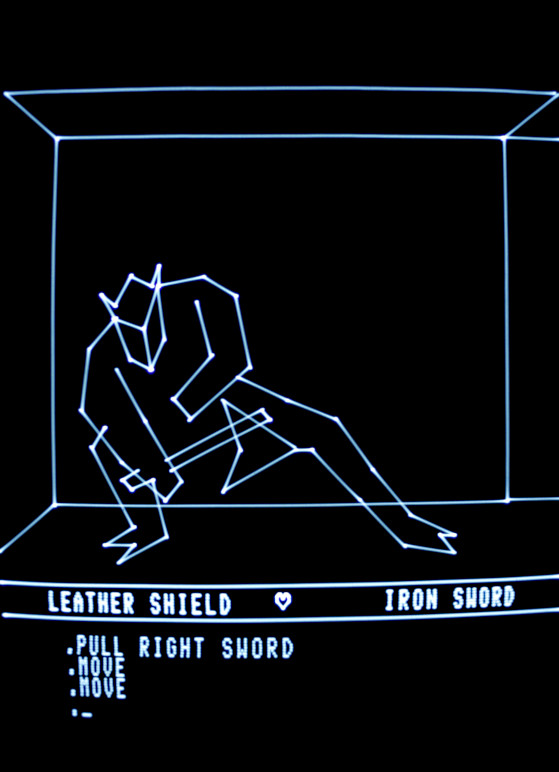VecFever documentation
Dungeons of Daggorath
History
This game was exclusively released for the RadioShack TRS-80 Color Computer which also uses a 6809 just like the Vectrex. That there were no other 8-bit ports back in the day is the reason that it remains unknown to most retro gamers, esp. in Europe. Which is especially sad since this is (as I now know) an excellent game for its time and due to the many fond memories of CoCo gamers back in the day there is quite a bit of information available like the manual, strategy guides, a bug fix, complete disassemblies of the CoCo cartridge and most importantly: even a fan-based PC port with released sources.
These sources provided a game framework as such but as usual all the i/o and game state management had to be ripped out and rewritten – it depended on a persistent display and used busy loops. Plus it is written in C++ and even though C++ can be almost as fast as C and with a low memory footprint similar to C code in principle, in reality I have yet to see after decades of development an actual, real-life example. For example: pulling in <stdio.h> for an sprintf in C would cost about 18KB of memory, the equivalent <iostream.h> for string output with C++ here was over 100KB. Even 18KB is quite hefty for a uProc environment but 100KB just for one function bordering on ridiculous. In the end I kept it C++ and just wrote streamlined C substitutes for the ‘offenders’.
Anyways, the game is indeed a role playing game with several unique design decisions: it hides the character statistics and you have to infer them by your interactions with the game world: eventually you do not get as tired anymore running around (at the beginning you will likely faint just running down a corridor too fast), you need less hits to kill a monster and in general your heartbeat does not go up quite as fast anymore. The original game uses keyboard commands – and frequently entered commands are already executed but not displayed yet – which has been kept here. There are not all that many commands so the movements are mapped onto the joystick plus 1: (turn around) and pressing 4: enters a ‘command entry mode’ where you first select a command and afterwards any modifiers (if necessary, e.g. drop item in <left> or <right> hand).
So, if you are intrigued do try it out – the very first thing you always have to do is a ‘pull left torch’, ‘use left’ combo. which first pulls a torch from your backpack (2: inventory) into your left hand and then lights it. Better read the manual first, though, there are also strategic hints in there, too.
Input
Joystick to move around (turn right/left, move (back))
- 1: turn around
- 2: examine/look (=enter/exit inventory)
- 4: command select (joystick to switch commands), another 4: to execute or 1: to cancel
Options
Please note: the bitmap text output type is inherited by the VF menu: so using ‘Fast Text’ mode will speed up the game’s output, too.
- Shield Bug: Fixed / Original
- Text: Full / Brief
- Game Info: ” © 1982 Dyna Micro. Amazing game developed exclusively for the Radioshack TRS-80 CoCo computer – and the original game fits into just an 8K cartridge. This version is based on the 2002 PC port of Richard Hunerlach but I had to change the code quite drastically to both get the memory footprint down and more importantly to structurally get a version not using a persistent video output. The entire input/output handling had to be removed and reimplemented.. The game does have a few differences besides the obvious to the original – like real vectors now and not those cute pixely, multi-color lines and similar but quite different sounds. The CoCo has a D/A conversion capability for sounds which results in very nice sound effects, something the AY891x chips cannot do while at the same time displaying vectors. However to do this on the CoCo the cpu is in a near-busy-loop and the game stops, only time (interrupts) advances then. This has an effect on the game – the player cannot interact but the timing for enemy actions still progresses – which is not emulated in this version since it would make the game even harder. And it is already hard. Really hard. I am not kidding, this game is brutally hard, esp. once you cleaned out the third dungeon (minus the demon). Then you just have to invest the time to build up your character by moving up the levels because trying to defeat the demon is either immediate suicide or you end up hopelessly underdeveloped on the 4th dungeon – and there is no way out and .very. demanding enemies await. Only by climbing up earlier the game penalizes the player by throwing ridiculously hard enemies at you, too.. 😛 Oh well, frequent saving is your friend here – just imagine for a second you were back in 1982 and had to wait for minutes for the cassette tape to load/store your save games ! “
Localization
//NAME="DAGORATH"
//
GERMAN[] = {
{ 0, 0, "Schildfehler: Original"},
{ 0, 0, "Schildfehler: Behoben"},
{ 0, 0, "Text: Voll"},
{ 0, 0, "Text: Kurz"},
{ 0, 0, 0}
};
FRENCH[] = {
{ 0, 0, "Bogue du Bouclier: Original"},
{ 0, 0, "Bogue du Bouclier: Supprimé"},
{ 0, 0, "Texte: Intégral"},
{ 0, 0, "Texte: Concis"},
{ 0, 0, " © 1982 Dyna Micro. Jeu incroyable développé exclusivement pour l'ordinateur Radioshack TRS-80 ou encore Tandy Color Computer, dénommé également 'CoCo' ; le jeu original tient dans une cartouche de 8 Ko seulement. Cette version est basée sur le portage PC de Richard Hunerlach réalisé en 2002. Toutefois, j'ai dû modifier le code de manière assez radicale pour réduire l'occupation de la mémoire et, surtout, pour obtenir une version structurellement non utilisable avec une sortie vidéo constante. Toute la gestion des entrées/sorties a dû être supprimée et ré-implémentée... Le jeu présente quelques différences en plus de celles qui sont évidentes au regard de l'original: en particulier de vrais vecteurs remplacent désormais les jolies lignes pixelisées/multicolores et les sons, bien qu'inscrits dans une continuité, sont assez différents. Il faut dire que le 'CoCo' dispose d'une capacité de conversion numérique/analogique des sons, ce qui donne de très beaux effets sonores, chose que les puces AY891x ne peuvent pas faire tout en affichant des vecteurs. Cependant, pour faire cela sur le CoCo, le processeur se retrouve dans une boucle quasi-saturée et le jeu s'arrête; dès lors seul le temps (au cours de l'interruption) s'écoule. Cela a une conséquence sur le déroulement de la partie: le joueur ne peut, pour sa part, pas interagir alors qu'en contrepartie le temps disponible continue à être consommé pour que soient menées à bien les actions ennemies; ceci n'est pas émulé dans cette version car cela rendrait le jeu encore plus difficile. Et c'est déjà assez difficile. Vraiment difficile. Je ne plaisante pas, le niveau de ce jeu est franchement relevé, surtout une fois qu'on a 'nettoyé' le troisième donjon (excepté le démon). Il faut alors optimiser le temps dont on dispose pour améliorer les caractéristiques de son personnage en progressant dans les niveaux, car essayer de vaincre prématurément le démon relève au pire du suicide immédiat, au mieux d'un manque cruel de moyens pour aborder le quatrième donjon, où il n'y a non seulement aucune issue, mais également des ennemis très coriaces qui attendent. Il faut se méfier de vouloir aller trop vite en besogne car le joueur se retrouve fatalement pénalisé par le jeu qui lui envoie des ennemis insurmontables...:P Oh, pour finir, un conseil: la sauvegarde fréquente est votre meilleure alliée ici - et puisque nous y sommes, imaginez juste un instant que vous vous retrouvez en 1982 et que vous devez à chaque fois attendre quelques minutes pour que le magnétophone à cassettes charge/enregistre les sauvegardes de vos jeux ! "}
};
ENGLISH[] = {
{ 0, 0, "Shield Bug: Original"},
{ 0, 0, "Shield Bug: Fixed"},
{ 0, 0, "Text: Full"},
{ 0, 0, "Text: Brief"},
{ 0, 0, " © 1982 Dyna Micro. Amazing game developed exclusively for the Radioshack TRS-80 CoCo computer - and the original game fits into just an 8K cartridge. This version is based on the 2002 PC port of Richard Hunerlach but I had to change the code quite drastically to both get the memory footprint down and more importantly to structurally get a version not using a persistent video output. The entire input/output handling had to be removed and reimplemented.. The game does have a few differences besides the obvious to the original - like real vectors now and not those cute pixely, multi-color lines and similar but quite different sounds. The CoCo has a D/A conversion capability for sounds which results in very nice sound effects, something the AY891x chips cannot do while at the same time displaying vectors. However to do this on the CoCo the cpu is in a near-busy-loop and the game stops, only time (interrupts) advances then. This has an effect on the game - the player cannot interact but the timing for enemy actions still progresses - which is not emulated in this version since it would make the game even harder. And it is already hard. Really hard. I am not kidding, this game is brutally hard, esp. once you cleaned out the third dungeon (minus the demon). Then you just have to invest the time to build up your character by moving up the levels because trying to defeat the demon is either immediate suicide or you end up hopelessly underdeveloped on the 4th dungeon - and there is no way out and .very. demanding enemies await. Only by climbing up earlier the game penalizes the player by throwing ridiculously hard enemies at you, too.. :P Oh well, frequent saving is your friend here - just imagine for a second you were back in 1982 and had to wait for minutes for the cassette tape to load/store your save games ! "}
};


